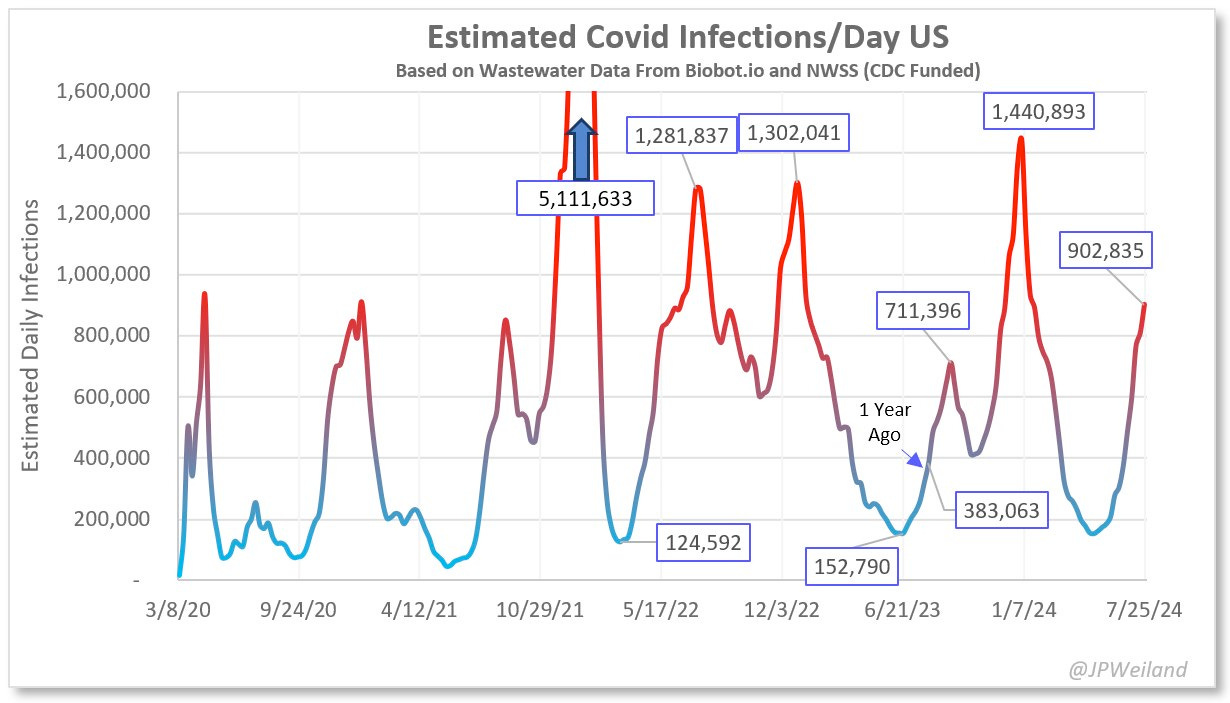There is a lot of COVID around. Now is a good time to take extra precautions to reduce your risk and protect those around you.
If you feel like a lot of people have COVID right now, you’re right. Recent estimates from wastewater data suggest over 900,000 new infections a day in the US and 1 in 37 people currently infected. Similar summer waves have been seen elsewhere including the UK and the Olympics in France.
Some things you can do to lower your risk of contracting and spreading COVID-19:
- Mind that ventilation– the virus travels by air!
- Dial up your strategic masking.
- Stay home if you feel sick and limit your interaction with others.
- Test for COVID if you have symptoms, a known exposure, or before visiting someone with higher risk (some tips on timing of tests here). You can also check out the US Test to Treat Program here.
- Stay up to date on your COVID vaccines (This is tricky timing since updated vaccines are due out in early September, but those who are at risk may still want to get one now and then later in the fall/winter season).
- If you test positive and are at higher risk for severe disease, seek out treatment like Paxlovid.
As you can see from the figure below, summer COVID waves are not unusual, but we’re already seeing higher levels than last summer and still rising.

Source: @JPWeiland
COVID is clearly not a single season virus, and we don’t know if it will ever fall into a truly predictable pattern. Why is this the case? SARS-CoV-2 seems more contagious than other respiratory pathogens like the flu. Remember that Reproductive or “R0” number from early in the pandemic? If R0 is greater than 1, it means that each infected person on average infects more than one person, and the wave of infections grows. Part of what determines the real world R number is the intrinsic transmissibility of a pathogen (how good it is at replicating in our cells and causing an infection if we are exposed), but the rest has to do with “host” factors like our current immunity levels and behaviors that increase our exposure like traveling and gathering indoors. For some pathogens, environmental factors like temperature and humidity can also affect its ability to survive and transmit. Because flu is not as intrinsically contagious as SARS-CoV-2, it requires certain conditions to tip over into R>1 and create a wave of infections. This predictably happens in the winter in the Northern Hemisphere and summer in the Southern Hemisphere, when low temperatures and humidity favor the virus and people are indoors in closer proximity. Without these conditions, the flu finds it hard to keep circulating year round. SARS-CoV-2 on the other hand, has much higher “intrinsic” transmissibility. This means that it is circulating at high enough levels all year that it always has the potential to tip the R number above 1 and cause a new wave. Since it’s still early days/years with COVID overall, we don’t yet know what drives the exact timing and size of waves. It likely has to do with 1) changes in human behavior with more traveling and gathering together, combined with 2) the timing of waning population immunity after previous vaccinations or infections. High levels of neutralizing antibodies necessary to block COVID infection seem to last only 4-6 months after vaccination or infection, especially as new variants that outsmart our immunity become dominant (protection from severe disease is more durable). As a higher proportion of the population gets six or more months past vaccination or infection, more people are susceptible and a new wave has a better chance of taking off.
COVID-19 isn’t going away. While it’s nice to think it has just become another “flu”, that’s just not true. The good news is that COVID-19 is a lot less deadly than in previous years because of our immunity from vaccines and previous infections. But it’s still a nasty virus that hospitalizes and kills many, and can cause longer term health issues such as Long Covid. Be careful out there y’all!
Stay safe, stay well.
Love,
Those Nerdy Girls


